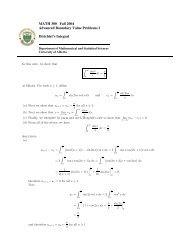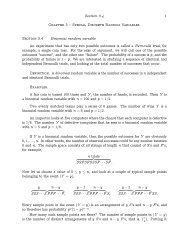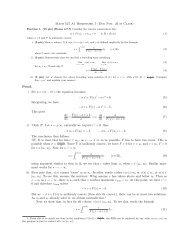Math 411: Honours Complex Variables - University of Alberta
Math 411: Honours Complex Variables - University of Alberta
Math 411: Honours Complex Variables - University of Alberta
You also want an ePaper? Increase the reach of your titles
YUMPU automatically turns print PDFs into web optimized ePapers that Google loves.
62 CHAPTER 9. HOLOMORPHIC FUNCTIONS ON ANNULI<br />
Finally, pick m ∈ Z and ρ ∈ (r,R). Note that<br />
f(z)<br />
=<br />
(z −z0) m+1<br />
∞�<br />
n=−∞<br />
an(z −z0) n−m−1 =<br />
converges uniformly on ∂Bρ(z0). Hence, we find<br />
�<br />
∂Bρ(z0)<br />
f(ζ)<br />
dζ =<br />
(ζ −z0) m+1<br />
∞�<br />
n=−∞<br />
an+m+1<br />
�<br />
∂Bρ(z0)<br />
∞�<br />
n=−∞<br />
(ζ−z0) n dζ = am<br />
noting that (ζ −z0) n has an antiderivative for all n �= −1. Thus<br />
am = 1<br />
�<br />
f(ζ)<br />
dζ<br />
2πi ∂Bρ(z0) (ζ −z0) m+1<br />
an+m+1(z −z0) n<br />
�<br />
∂Bρ(z0)<br />
1<br />
dζ = 2πiam,<br />
ζ −z0<br />
Corollary 9.3.1. Let z0 ∈ C, let r > 0, and let f: Br(z0)\{z0} → C be holomorphic<br />
with Laurent representation f(z) = � ∞<br />
n=−∞ an(z−z0) n . Then the singularity z0 <strong>of</strong> f<br />
is<br />
(i) removable if and only if an = 0 for n < 0;<br />
(ii) a pole <strong>of</strong> order k ∈ N if and only if a−k �= 0 and an = 0 for all n < −k;<br />
(iii) essential if and only if an �= 0 for infinitely many n < 0.<br />
Pro<strong>of</strong>.<br />
(i) The “if” part follows from Theorem 6.3.<br />
Conversely, suppose that z0 is a removable singularity, and let ˜ f : Br(z0) → C<br />
be a holomorphic extension <strong>of</strong> f with Taylor expansion ˜ f(z) = �∞ n<br />
n=0bn(z−z0) for z ∈ Br(z0). The uniqueness <strong>of</strong> the Laurent representation yields an = bn for<br />
n ∈ N0 and an = 0 for n < 0.<br />
(ii) For the “if” part, set<br />
g(z) := (z −z0) k f(z) =<br />
∞�<br />
n=−k<br />
an(z −z0) n+k<br />
for z ∈ Br(z0)\{z0}. Then g extends holomorphically to Br(z0) with g(z0) =<br />
a−k �= 0. By definition, we have f(z) = g(z)<br />
(z−z0) k for z ∈ Br(z0)\{z0}. Hence, f<br />
has a pole <strong>of</strong> order k at z0.







